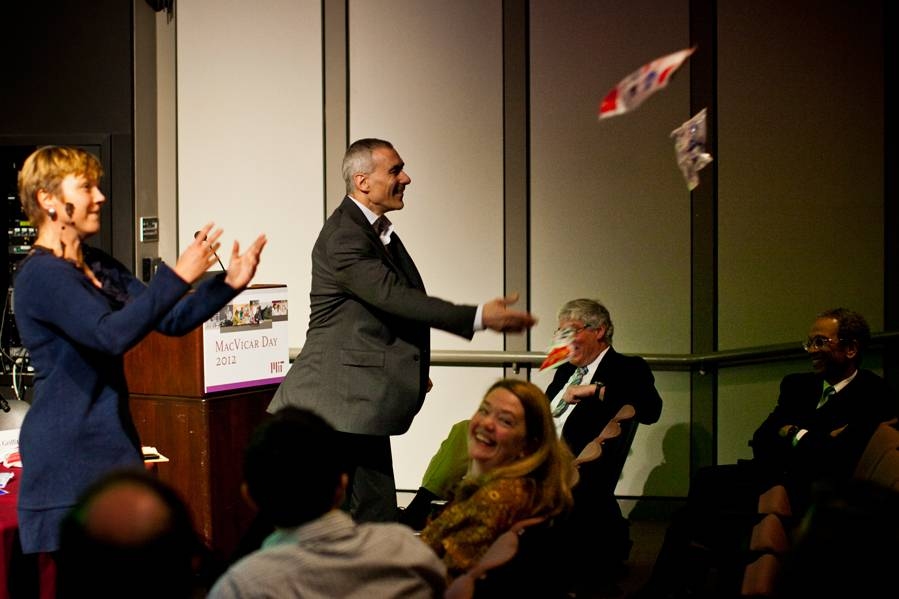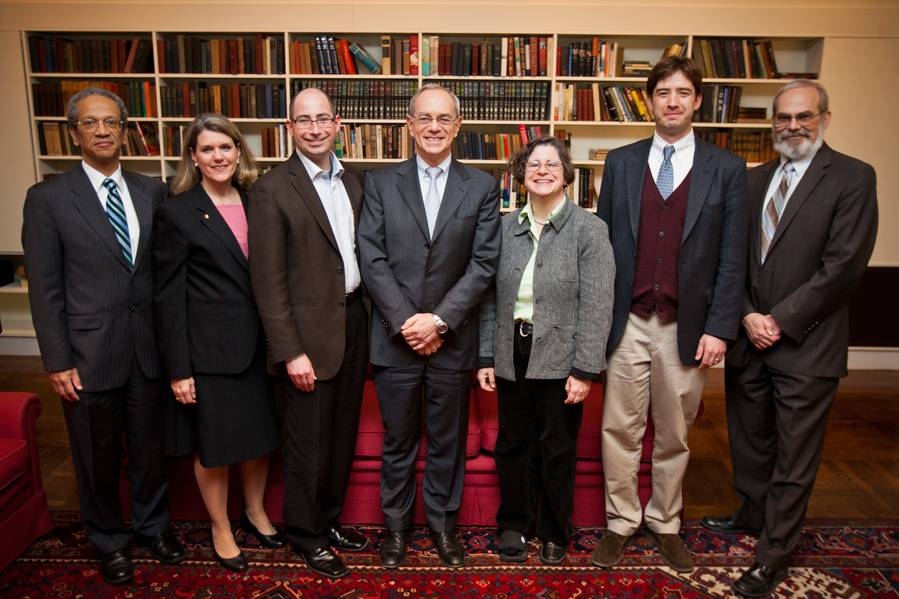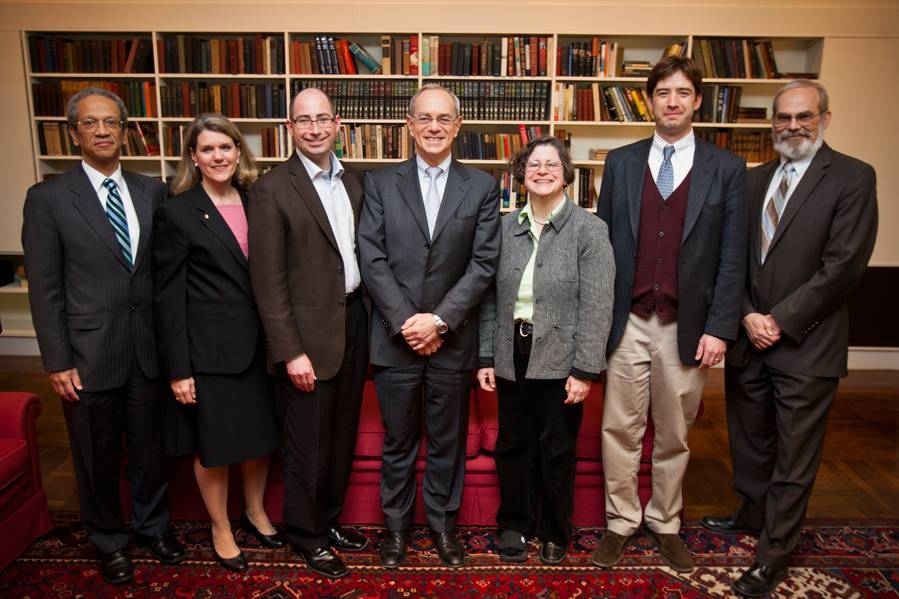Where there’s chemistry, there’s often energy, usually in the form of heat lost or gained. Anyone who has ever used an instant ice or heat pack to relieve aching muscles has experienced this relationship between chemistry and energy: When one of these packs is bent in half, chemicals from separate compartments mix together, activating a spontaneous thermodynamic reaction that either releases heat or draws it in, depending on whether the pack is meant to be hot or cold.
This simple example of free energy was a favorite of the late Robert Silbey, a chemistry professor and MIT’s former dean of science, who used the therapeutic packs to great effect in his undergraduate thermodynamics class for years. Silbey, who passed away last October, was honored last Friday at MacVicar Day, an annual event held to celebrate the current MacVicar Fellows.
The MacVicar Fellowship was established in 1992 to honor the teaching contributions of Margaret MacVicar '64, ScD '67, MIT’s first dean for undergraduate education and founder of the Undergraduate Research Opportunities Program (UROP). This year’s event paid tribute to both MacVicar and Silbey in a symposium titled “Innovations in Undergraduate Education at MIT.”
As a tribute to Silbey’s spirit of teaching and collaboration, his colleagues re-enacted part of his favorite thermodynamics lecture, tossing out cold and hot packs to a surprised and delighted audience in Bartos Theatre.
The exercise illustrated not only Silbey’s enthusiasm and creativity in teaching, but also his knack for bridging disciplines across the MIT campus: The demonstration was part of a thermodynamics course in which faculty from both the chemistry and biological engineering departments co-taught the material.
“Working across boundaries was something Bob believed in,” said Linda Griffith, the School of Engineering Professor of Innovative Teaching in the Department of Biological Engineering, who taught the class with Silbey.
Over the course of the event, Griffith and others spoke of Silbey’s efforts to foster collaboration in undergraduate education, including his work heading up MIT’s Task Force on Student Life and Learning, with John Hansman, a professor of aeronautics and astronautics. The task force was established in 1996 and sought to evaluate MIT’s educational mission for the 21st century.
“Bob saw breadth in undergraduate education,” said Diana Henderson, the dean for curriculum and faculty support and a professor of literature at MIT. “Today we’re trying to establish the principles of that community that keeps on going.”
In looking to the future of MIT’s undergraduate education, John Essigmann, the William and Betsy Leitch Professor of Toxicology and Chemistry and housemaster of Simmons Hall, stressed the need to improve “collegiality” between students and faculty, both in and out of the classroom.
“A chemist like Bob would say, ‘What can we do to accelerate this process?’” Essigmann said. “There needs to be a catalyst.”
Essigmann said that new buildings on campus have served as architectural catalysts, including the renovated undergraduate dorm Maseeh Hall, whose dining facility has brought faculty across the “semipermeable membrane” of Massachusetts Avenue to mix with students outside the classroom.
Following on the architectural theme, William Broadhead, a new MacVicar Fellow and the Class of '54 Career Development Associate Professor of History, made note of an inscription on MIT’s Building 6 by the Roman poet Virgil, praising the practicality of the physical sciences. Broadhead ventured a guess that the inscription was originally chosen to lend some literary “gravitas” to the building, but that it also may suggest that science and the humanities — seemingly disparate disciplines — may be taught in tandem.
Broadhead is one of 11 faculty members in the Department of Ancient and Medieval Studies who work closely together to “emphasize similarities and synergies between different disciplines,” he said. “We punch above our weight because of our collaborations.”
In closing the event, Robert Redwine, a professor of physics and former dean of undergraduate education, made note of the many “wonderful teachers around the Institute doing very dedicated, innovative things.”
Redwine was the fourth of MIT’s five deans for undergraduate education, following in MacVicar’s footsteps. He recalled that when he was first considering taking the post in 2000, Silbey advised against it — a response that was puzzling at first.
“He was basically testing me to see how serious I was about this,” Redwine said. “When he was sure, he embraced me fully as a partner in education.”
Through the years, Redwine and Silbey worked together with many colleagues across campus to improve undergraduate education.
“This really is the rock base of MIT, the undergraduate aspect,” Redwine said. “We want to continue to feel like an undergraduate institution as well as being a great place to go to graduate school, and I think we do.”
Other speakers at the event included Moungi Bawendi, the Lester Wolfe Professor of Chemistry; Arthur Bahr, an associate professor of literature; and Joel Yuen ’07, a PhD candidate at Harvard University who conducted undergraduate research under Silbey.
The 2012 MacVicar Fellows are Broadhead; Leslie Pack Kaelbling, the Panasonic Professor of Computer Science and Engineering; David Kaiser, the Germeshausen Professor of the History of Science; and Nancy Lin Rose, the Charles P. Kindleberger Professor of Applied Economics.
This simple example of free energy was a favorite of the late Robert Silbey, a chemistry professor and MIT’s former dean of science, who used the therapeutic packs to great effect in his undergraduate thermodynamics class for years. Silbey, who passed away last October, was honored last Friday at MacVicar Day, an annual event held to celebrate the current MacVicar Fellows.
The MacVicar Fellowship was established in 1992 to honor the teaching contributions of Margaret MacVicar '64, ScD '67, MIT’s first dean for undergraduate education and founder of the Undergraduate Research Opportunities Program (UROP). This year’s event paid tribute to both MacVicar and Silbey in a symposium titled “Innovations in Undergraduate Education at MIT.”
As a tribute to Silbey’s spirit of teaching and collaboration, his colleagues re-enacted part of his favorite thermodynamics lecture, tossing out cold and hot packs to a surprised and delighted audience in Bartos Theatre.
The exercise illustrated not only Silbey’s enthusiasm and creativity in teaching, but also his knack for bridging disciplines across the MIT campus: The demonstration was part of a thermodynamics course in which faculty from both the chemistry and biological engineering departments co-taught the material.
“Working across boundaries was something Bob believed in,” said Linda Griffith, the School of Engineering Professor of Innovative Teaching in the Department of Biological Engineering, who taught the class with Silbey.
Over the course of the event, Griffith and others spoke of Silbey’s efforts to foster collaboration in undergraduate education, including his work heading up MIT’s Task Force on Student Life and Learning, with John Hansman, a professor of aeronautics and astronautics. The task force was established in 1996 and sought to evaluate MIT’s educational mission for the 21st century.
“Bob saw breadth in undergraduate education,” said Diana Henderson, the dean for curriculum and faculty support and a professor of literature at MIT. “Today we’re trying to establish the principles of that community that keeps on going.”
In looking to the future of MIT’s undergraduate education, John Essigmann, the William and Betsy Leitch Professor of Toxicology and Chemistry and housemaster of Simmons Hall, stressed the need to improve “collegiality” between students and faculty, both in and out of the classroom.
“A chemist like Bob would say, ‘What can we do to accelerate this process?’” Essigmann said. “There needs to be a catalyst.”
Essigmann said that new buildings on campus have served as architectural catalysts, including the renovated undergraduate dorm Maseeh Hall, whose dining facility has brought faculty across the “semipermeable membrane” of Massachusetts Avenue to mix with students outside the classroom.
Following on the architectural theme, William Broadhead, a new MacVicar Fellow and the Class of '54 Career Development Associate Professor of History, made note of an inscription on MIT’s Building 6 by the Roman poet Virgil, praising the practicality of the physical sciences. Broadhead ventured a guess that the inscription was originally chosen to lend some literary “gravitas” to the building, but that it also may suggest that science and the humanities — seemingly disparate disciplines — may be taught in tandem.
Broadhead is one of 11 faculty members in the Department of Ancient and Medieval Studies who work closely together to “emphasize similarities and synergies between different disciplines,” he said. “We punch above our weight because of our collaborations.”
In closing the event, Robert Redwine, a professor of physics and former dean of undergraduate education, made note of the many “wonderful teachers around the Institute doing very dedicated, innovative things.”
Redwine was the fourth of MIT’s five deans for undergraduate education, following in MacVicar’s footsteps. He recalled that when he was first considering taking the post in 2000, Silbey advised against it — a response that was puzzling at first.
“He was basically testing me to see how serious I was about this,” Redwine said. “When he was sure, he embraced me fully as a partner in education.”
Through the years, Redwine and Silbey worked together with many colleagues across campus to improve undergraduate education.
“This really is the rock base of MIT, the undergraduate aspect,” Redwine said. “We want to continue to feel like an undergraduate institution as well as being a great place to go to graduate school, and I think we do.”
Other speakers at the event included Moungi Bawendi, the Lester Wolfe Professor of Chemistry; Arthur Bahr, an associate professor of literature; and Joel Yuen ’07, a PhD candidate at Harvard University who conducted undergraduate research under Silbey.
The 2012 MacVicar Fellows are Broadhead; Leslie Pack Kaelbling, the Panasonic Professor of Computer Science and Engineering; David Kaiser, the Germeshausen Professor of the History of Science; and Nancy Lin Rose, the Charles P. Kindleberger Professor of Applied Economics.








